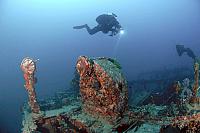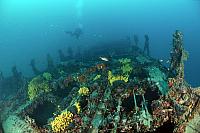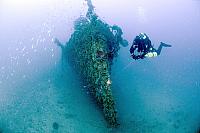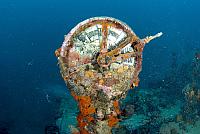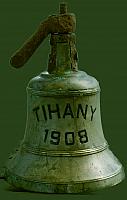TIHANY
Il Tihany, costruito nel 1907 e completato nel 1908 nello Stabilimento Tecnico Triestino con il numero di costruzione 385, fu uno dei molti piroscafi mercantili che navigavano lungo la costa orientale dell’Adriatico all’inizio del XX secolo. Lo scafo della nave era in ferro, lungo 45,40 metri e largo 5,75 con la sovrastruttura nella parte centrale, dove c’era il ponte di comando aperto, dietro il quale si trovava un fumaiolo alto e stretto con una stella disegnata a metà altezza. Due alberi con le gru venivano usati per il carico e lo scarico delle merci dalla stiva, i cui boccaporti si trovavano nella parte anteriore e posteriore della nave. Dietro l’albero di poppa, c’era una sovrastruttura minore in legno, probabilmente adibita ad alloggio per l’equipaggio. Il Tihany, che prese il nome dall’omonimo paese in Ungheria, navigò lungo la costa adriatica orientale, al servizio della compagnia Società per Azioni Ungaro-Croata di Navigazione Marittima a vapore con sede a Fiume. Durante la prima guerra mondiale venne ceduto alla marina militare austro-ungherese. Nella notte del 12 febbraio 1917 in navigazione da Bar a Kotor, giunta all’ingresso delle Bocche di Cattaro, la nave affondò di fronte all’isola di Mamola per motivi non chiari. Con la nave affondarono anche il carico di carbone e un vagone d’olio, ma tutti i membri dell’equipaggio si salvarono e il naufragio non provocò vittime.
il relitto è appoggiato in assetto di navigazione su un fondale sabbioso di 40 metri, presenta una struttura dello scafo ben conservata, mentre il ponte principale in legno è in molte parti assente e degradato. Non sono presenti sul relitto, tuttavia, reti o lenze che possano rendere l’immersione pericolosa. Nella zona centrale, nella parte superiore del castello di comando, si trova il telegrafo di macchina, di grande interesse, poiché all’interno sono ancora leggibili le scritte di manovra in lingua italiana. La prora, dove si trova la cima di discesa tra la zona argani e le stive, è dritta, verticale ed affilata, mentre la struttura della poppa tondeggiante è la parte meglio conservata. Nella parte sottostante, la gabbia dell’elica è priva dell’elica stessa e del timone.
Addentrandosi al suo interno con qualche cautela dalle zone alte in cui il ponte di coperta non è presente, è possibile scorgere infine la cucina, un servizio igienico e la sala macchine. (C. Balzi)
The Tihany, built in 1907 and completed in 1908 in the Triestino Technical Factory with the building number 385, was one of many merchant steamers sailing along the east coast of the Adriatic at the beginning of the 20th century. The ship's hull was iron, 45.40 meters long and 5.75 meters wide with the superstructure in the central part, where there was the open control deck, behind which was a tall, narrow chimney with a star drawn at mid-height. Two masts with cranes were used to load and unload goods from the hold, whose hatches were in the front and back of the ship. Behind the aft shaft, there was a minor wooden superstructure, probably used as accommodation for the crew. The Tihany, named after the country of the same name in Hungary, sailed along the eastern Adriatic coast, serving the Company for Ungaro-Croat Shares of Maritime Steam Navigation based in Rijeka. During World War I, she was transferred to the Austro-Hungarian Navy. On the night of 12 February 1917, sailing from Bar to Kotor, reached the entrance of the Mouths of Cattaro, the ship sank in front of the island of Mamola for unclear reasons. The ship also sank the cargo of coal and an oil wagon, but all the crew members were rescued and the shipwreck did not cause any casualties.
The wreck is resting in navigational trim on a sandy seabed of 40 meters, has a well-preserved hull structure, while the main wooden bridge is in many parts absent and degraded. There are no nets or lines on the wreck that can make diving dangerous. In the central area, at the top of the command castle, there is the machine telegraph, of great interest, since inside are still legible the writings in the Italian language. The bow, where the rope of descent between the winch zone and the holds, is straight, vertical and sharp, while the structure of the rounded stern is the best preserved part. In the underside, the propeller cage is devoid of the propeller itself and the rudder.
By entering it with some caution from the high areas where the deck is not present, you can finally see the kitchen, a toilet and the engine room.(C.Balzi)
il relitto è appoggiato in assetto di navigazione su un fondale sabbioso di 40 metri, presenta una struttura dello scafo ben conservata, mentre il ponte principale in legno è in molte parti assente e degradato. Non sono presenti sul relitto, tuttavia, reti o lenze che possano rendere l’immersione pericolosa. Nella zona centrale, nella parte superiore del castello di comando, si trova il telegrafo di macchina, di grande interesse, poiché all’interno sono ancora leggibili le scritte di manovra in lingua italiana. La prora, dove si trova la cima di discesa tra la zona argani e le stive, è dritta, verticale ed affilata, mentre la struttura della poppa tondeggiante è la parte meglio conservata. Nella parte sottostante, la gabbia dell’elica è priva dell’elica stessa e del timone.
Addentrandosi al suo interno con qualche cautela dalle zone alte in cui il ponte di coperta non è presente, è possibile scorgere infine la cucina, un servizio igienico e la sala macchine. (C. Balzi)
The Tihany, built in 1907 and completed in 1908 in the Triestino Technical Factory with the building number 385, was one of many merchant steamers sailing along the east coast of the Adriatic at the beginning of the 20th century. The ship's hull was iron, 45.40 meters long and 5.75 meters wide with the superstructure in the central part, where there was the open control deck, behind which was a tall, narrow chimney with a star drawn at mid-height. Two masts with cranes were used to load and unload goods from the hold, whose hatches were in the front and back of the ship. Behind the aft shaft, there was a minor wooden superstructure, probably used as accommodation for the crew. The Tihany, named after the country of the same name in Hungary, sailed along the eastern Adriatic coast, serving the Company for Ungaro-Croat Shares of Maritime Steam Navigation based in Rijeka. During World War I, she was transferred to the Austro-Hungarian Navy. On the night of 12 February 1917, sailing from Bar to Kotor, reached the entrance of the Mouths of Cattaro, the ship sank in front of the island of Mamola for unclear reasons. The ship also sank the cargo of coal and an oil wagon, but all the crew members were rescued and the shipwreck did not cause any casualties.
The wreck is resting in navigational trim on a sandy seabed of 40 meters, has a well-preserved hull structure, while the main wooden bridge is in many parts absent and degraded. There are no nets or lines on the wreck that can make diving dangerous. In the central area, at the top of the command castle, there is the machine telegraph, of great interest, since inside are still legible the writings in the Italian language. The bow, where the rope of descent between the winch zone and the holds, is straight, vertical and sharp, while the structure of the rounded stern is the best preserved part. In the underside, the propeller cage is devoid of the propeller itself and the rudder.
By entering it with some caution from the high areas where the deck is not present, you can finally see the kitchen, a toilet and the engine room.(C.Balzi)
- Primo Precedente
- Foto 1 - 8 di 8
- Prossimo Ultimo

